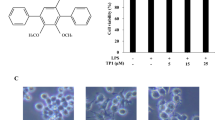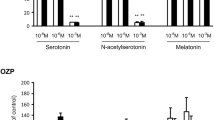Abstract
Immunomodulatory actions exerted by some classes of tryptamines, such as benzoyltryptamine analogues, suggest these molecules as promising candidates to develop new therapies to treat conditions associated to acute and chronic pain and inflammation. N-salicyloyltryptamine (STP) was observed to act as an anticonvulsive agent and exert antinociceptive effects in mouse. In the present work, we performed a screening of cytotoxic, cytoprotective, immunomodulatory, and redox properties of STP in RAW 264.7 macrophages challenged with hydrogen peroxide and LPS. Our results show that STP presents no cytotoxicity in the range of 0.001 to 1 μg/mL, but doses of 50 and 100 μg/mL caused loss of cell viability (IC50 = 22.75 μg/mL). Similarly, STP at 0.001 to 1 μg/mL did not cause oxidative stress to RAW 264.7 cells, although it did not prevent cell death induced by H2O2 0.5 mM. At 1 μg/mL, STP reversed some redox and inflammatory parameters induced by LPS. These include thiol (sulfhydryl) oxidation, superoxide dismutase activation, and morphological changes associated to macrophage activation. Besides, STP significantly inhibited LPS-induced TNF-α and IL-1β release, as well as CD40 and TNF-α protein upregulation. Signaling events induced by LPS, such as phosphorylation of ERK 1/2 and IκBα and p65 nuclear translocation (NF-kB activation) were also inhibited by STP. These data indicate that STP is able to modulate inflammatory parameters at doses that do not interfere in cell viability.







Similar content being viewed by others
References
Abramson SB. Nitric oxide in inflammation and pain associated with osteoarthritis. Arthritis Res Ther. 2008;10 Suppl 2:S2.
Araujo DA et al. N-salicyloyltryptamine, a new anticonvulsant drug, acts on voltage-dependent Na+, Ca2+, and K+ ion channels. Br J Pharmacol. 2003;140:1331–9.
Bopp C, Bierhaus A, Hofer S, Bouchon A, Nawroth PP, Martin E, et al. Bench-to-bedside review: the inflammation-perpetuating pattern-recognition receptor RAGE as a therapeutic target in sepsis. Crit Care. 2008;12:201.
Bowie A, O’Neill LA. Oxidative stress and nuclear factor-kappaB activation: a reassessment of the evidence in the light of recent discoveries. Biochem Pharmacol. 2000;59:13–23.
Cuzzocrea S, Zingarelli B, Gilad E, Hake P, Salzman AL, Szabo C. Protective effect of melatonin in carrageenan-induced models of local inflammation: relationship to its inhibitory effect on nitric oxide production and its peroxynitrite scavenging activity. J Pineal Res. 1997;23:106–16.
De Bittencourt Pasquali MA et al. Vitamin A (retinol) downregulates the receptor for advanced glycation endproducts (RAGE) by oxidant-dependent activation of p38 MAPK and NF-kB in human lung cancer A549 cells. Cell Signal. 2013;25:939–54.
de Souza LF, Gelain DP, Jardim FR, Ribeiro GR, Zim M, Bernard EA. Extracellular inosine participates in tumor necrosis factor-alpha induced nitric oxide production in cultured Sertoli cells. Mol Cell Biochem. 2006;281:123–8.
Deneris ES, Wyler SC. Serotonergic transcriptional networks and potential importance to mental health. Nat Neurosci. 2012;15:519–27.
Dieudonne S. Serotonergic neuromodulation in the cerebellar cortex: cellular, synaptic, and molecular basis. Neuroscientist. 2001;7:207–19.
Ellman GL. Tissue sulfhydryl groups. Arch Biochem Biophys. 1959;82:70–7.
Evans MS, Cheng X, Jeffry JA, Disney KE, Premkumar LS. Sumatriptan inhibits TRPV1 channels in trigeminal neurons. Headache. 2012;52:773–84.
Foey AD, Feldmann M, Brennan FM. CD40 ligation induces macrophage IL-10 and TNF-alpha production: differential use of the PI3K and p42/44 MAPK-pathways. Cytokine. 2001;16:131–42.
Gelain DP, De Bittencourt Pasquali MA, Caregnato FF, Zanotto-Filho A, Moreira JC. Retinol up-regulates the receptor for advanced glycation endproducts (RAGE) by increasing intracellular reactive species. Toxicol In Vitro. 2008;22:1123–7.
Gelain DP, Moreira JC. Evidence of increased reactive species formation by retinol, but not retinoic acid, in PC12 cells. Toxicol In Vitro. 2008;22:553–8.
Halliwell B, Gutteridge JMC. Free radicals in biology and medicine. Oxford: Oxford University Press; 2007.
Jhee SS, Shiovitz T, Crawford AW, Cutler NR. Pharmacokinetics and pharmacodynamics of the triptan antimigraine agents: a comparative review. Clin Pharmacokinet. 2001;40:189–205.
Jones RS. Tryptamine: a neuromodulator or neurotransmitter in mammalian brain? Prog Neurobiol. 1982;19:117–39.
Kang EH, Gebru E, Kim MH, Cheng H, Park SC. EstA protein, a novel virulence factor of Streptococcus pneumoniae, induces nitric oxide and pro-inflammatory cytokine production in RAW 264.7 macrophages through NF-kappaB/MAPK. Microb Pathog. 2009;47:196–201.
Kenneth NS, Mudie S, Naron S, Rocha S. TFR1 interacts with the IKK complex and is involved in IKK-NF-kappaB signalling. Biochem J. 2013;449:275–84.
Lin QQ, Yan CF, Lin R, Zhang JY, Wang WR, Yang LN, et al. SIRT1 regulates TNF-alpha-induced expression of CD40 in 3 T3-L1 adipocytes via NF-kappaB pathway. Cytokine. 2012;60:447–55.
Maczurek A, Shanmugam K, Munch G. Inflammation and the redox-sensitive AGE-RAGE pathway as a therapeutic target in Alzheimer’s disease. Ann N Y Acad Sci. 2008;1126:147–51.
Mayo JC, Sainz RM, Tan DX, Hardeland R, Leon J, Rodriguez C, et al. Anti-inflammatory actions of melatonin and its metabolites, N1-acetyl-N2-formyl-5-methoxykynuramine (AFMK) and N1-acetyl-5-methoxykynuramine (AMK), in macrophages. J Neuroimmunol. 2005;165:139–49.
Misra HP, Fridovich I. The role of superoxide anion in the autoxidation of epinephrine and a simple assay for superoxide dismutase. J Biol Chem. 1972;247:3170–5.
Missbach M, Jagher B, Sigg I, Nayeri S, Carlberg C, Wiesenberg I. Thiazolidine diones, specific ligands of the nuclear receptor retinoid Z receptor/retinoid acid receptor-related orphan receptor alpha with potent antiarthritic activity. J Biol Chem. 1996;271:13515–22.
Nava F, Calapai G, Facciola G, Cuzzocrea S, Giuliani G, de Sarro A, et al. Melatonin effects on inhibition of thirst and fever induced by lipopolysaccharide in rat. Eur J Pharmacol. 1997;331:267–74.
Neeb L, Hellen P, Boehnke C, Hoffmann J, Schuh-Hofer S, Dirnagl U, et al. IL-1beta stimulates COX-2 dependent PGE(2) synthesis and CGRP release in rat trigeminal ganglia cells. PLoS One. 2011;6:e17360.
Nosal R, Perecko T, Jancinova V, Drabikova K, Harmatha J, Svitekova K. Suppression of oxidative burst in human neutrophils with the naturally occurring serotonin derivative isomer from Leuzea carthamoides. Neuro Endocrinol Lett. 2010;31 Suppl 2:69–72.
Oliveira FA, de Almeida RN, Sousa MF, Barbosa-Filho JM, Diniz SA, de Medeiros IA. Anticonvulsant properties of N-salicyloyltryptamine in mice. Pharmacol Biochem Behav. 2001;68:199–202.
Quintans LJ et al. Bioassay-guided evaluation of antinociceptive effect of N-salicyloyltryptamine: a behavioral and electrophysiological approach. J Biomed Biotechnol. 2010;2010:230745.
Raghavendra V, Agrewala JN, Kulkarni SK. Role of centrally administered melatonin and inhibitors of COX and NOS in LPS-induced hyperthermia and adipsia. Prostaglandins Leukot Essent Fatty Acids. 1999;60:249–53.
Raghavendra V, Agrewala JN, Kulkarni SK. Melatonin reversal of lipopolysacharides-induced thermal and behavioral hyperalgesia in mice. Eur J Pharmacol. 2000;395:15–21.
Rehman MU, Yoshihisa Y, Miyamoto Y, Shimizu T. The anti-inflammatory effects of platinum nanoparticles on the lipopolysaccharide-induced inflammatory response in RAW 264.7 macrophages. Inflamm Res. 2012;61:1177–85.
Sacco S, Aquilini L, Ghezzi P, Pinza M, Guglielmotti A. Mechanism of the inhibitory effect of melatonin on tumor necrosis factor production in vivo and in vitro. Eur J Pharmacol. 1998;343:249–55.
Salvemini D, Doyle TM, Cuzzocrea S. Superoxide, peroxynitrite and oxidative/nitrative stress in inflammation. Biochem Soc Trans. 2006;34:965–70.
Scott MJ, Hoth JJ, Stagner MK, Gardner SA, Peyton JC, Cheadle WG. CD40–CD154 interactions between macrophages and natural killer cells during sepsis are critical for macrophage activation and are not interferon gamma dependent. Clin Exp Immunol. 2004;137:469–77.
Shih MF, Chen LY, Tsai PJ, Cherng JY. In vitro and in vivo therapeutics of beta-thujaplicin on LPS-induced inflammation in macrophages and septic shock in mice. Int J Immunopathol Pharmacol. 2012;25:39–48.
Silveira G, de Oliveira AC, Teixeira AL. Insights into inflammation and epilepsy from the basic and clinical sciences. J Clin Neurosci. 2012;19:1071–5.
Sims GP, Rowe DC, Rietdijk ST, Herbst R, Coyle AJ. HMGB1 and RAGE in inflammation and cancer. Annu Rev Immunol. 2010;28:367–88.
Skehan P, Storeng R, Scudiero D, Monks A, McMahon J, Vistica D, et al. New colorimetric cytotoxicity assay for anticancer-drug screening. J Natl Cancer Inst. 1990;82:1107–12.
Suttles J, Stout RD. Macrophage CD40 signaling: a pivotal regulator of disease protection and pathogenesis. Semin Immunol. 2009;21:257–64.
Vendramini-Costa DB, Carvalho JE. Molecular Link Mechanisms between Inflammation and Cancer. Curr Pharm Des. 2012;18:3831–52.
Wang Z, Jiang W, Zhang Z, Qian M, Du B. Nitidine chloride inhibits LPS-induced inflammatory cytokines production via MAPK and NF-kappaB pathway in RAW 264.7 cells. J Ethnopharmacol. 2012;144:145–50.
Yang L, Zhang J, Yan C, Zhou J, Lin R, Lin Q, et al. SIRT1 regulates CD40 expression induced by TNF-alpha via NF-kB pathway in endothelial cells. Cell Physiol Biochem. 2012;30:1287–98.
Yu AM. Indolealkylamines: biotransformations and potential drug–drug interactions. AAPS J. 2008;10:242–53.
Acknowledgments
This work was funded by grants from the Brazilian governmental agencies FAPERGS (PqG 12/0998-0, ARD 11/1893-7, PRONEX 1000274) CAPES (PROCAD 066/2007), CNPq, IBN-Net (#01.06.0842-00), INCT-EN, and PROPESQ-UFRGS.
Author information
Authors and Affiliations
Corresponding author
Rights and permissions
About this article
Cite this article
Gasparotto, J., de Bittencourt Pasquali, M.A., Somensi, N. et al. Effect of N-salicyloyltryptamine (STP), a novel tryptamine analogue, on parameters of cell viability, oxidative stress, and immunomodulation in RAW 264.7 macrophages. Cell Biol Toxicol 29, 175–187 (2013). https://doi.org/10.1007/s10565-013-9245-2
Received:
Accepted:
Published:
Issue Date:
DOI: https://doi.org/10.1007/s10565-013-9245-2




